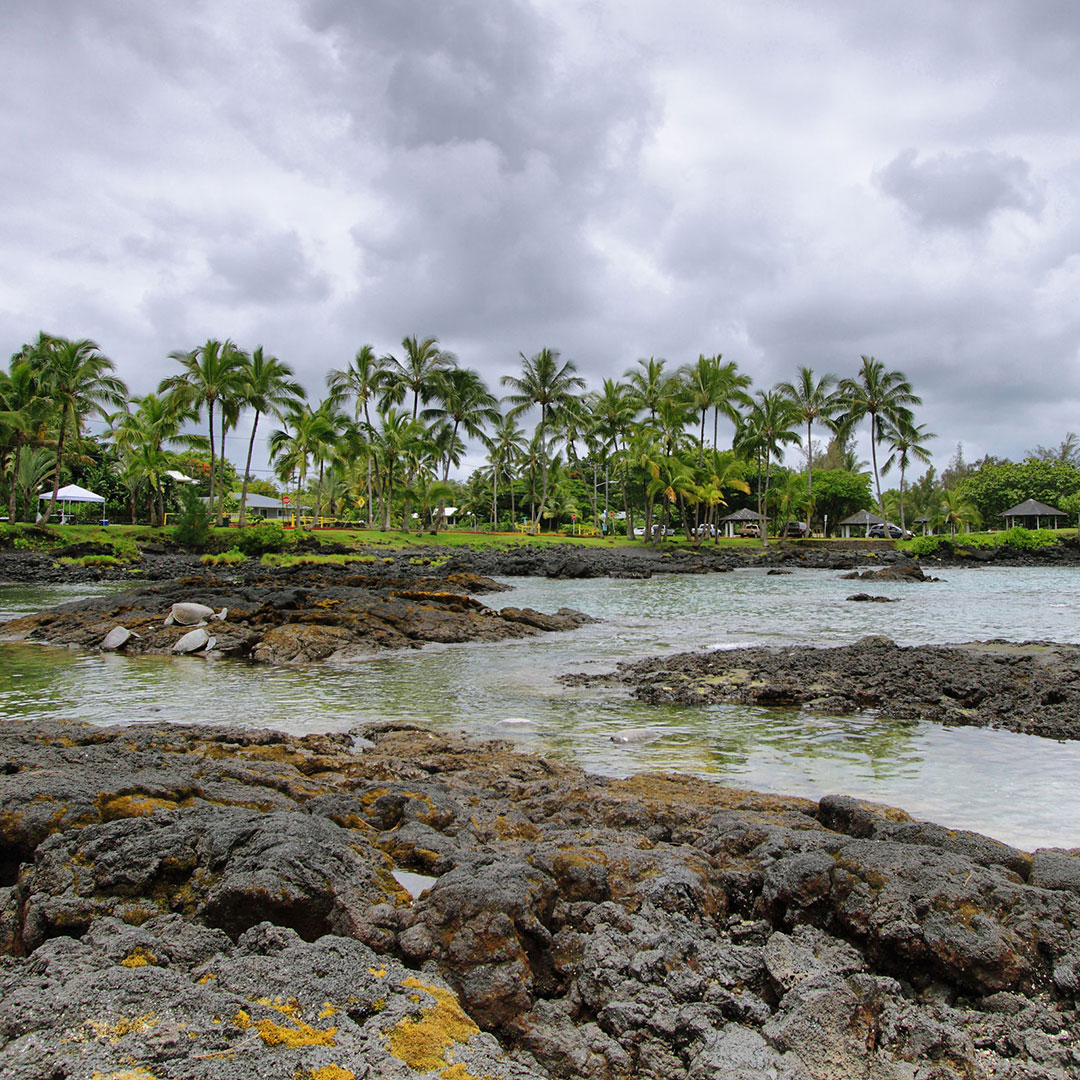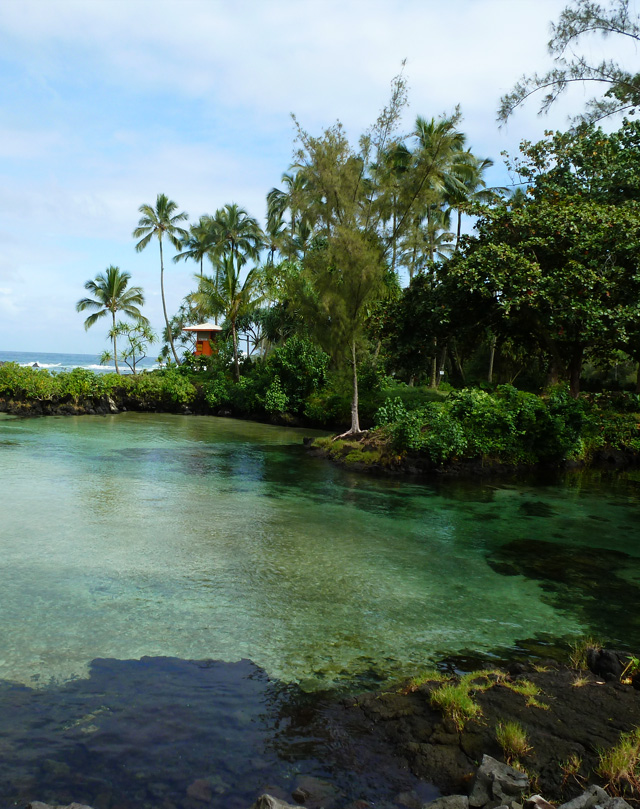Hilo’s Best Beaches, Hawaii’s Big Island
If you define a beach as a long expanse of white sand covered by a thousand sunbathers and their beach umbrellas, then Hilo doesn’t have any. If a beach, to you, can be a smaller, more intimate affair where a good number of tourists and families can spend the day on pockets of sand between fingers of black lava, then Hilo has a few. Hilo’s beaches are small and rocky—perfect for keeping crowds away. The best beaches all lie to the east of the city along Kalaniana‘ole Avenue, an area known as the Keaukaha Strip, which runs six miles from downtown Hilo to its dead end at Leleiwi Point. Not all beaches are clearly marked, but even those are easily identified by the cars parked along the road.

Downtown Hilo and the Bayfront
Hilo Bayfront Park
A thousand yards of gray-black sand that narrows considerably as it runs west from the Wailoa River toward downtown, at one time Hilo Bayfront Park (along Kamehameha Ave.) went all the way to the Wailuku River and was renowned throughout the islands for its beauty, but commercialism of the waterfront ruined it. By 1960, so much sewage and industrial waste had been pumped into the bay that it was considered a public menace, and then the great tsunami came. Reclamation projects created the Wailoa River State Recreation Area at the east end, and shorefront land became a buffer zone against future inundation.
Few swimmers come to the beach because the water is cloudy and chilly, but the sharks don’t seem to mind! The bay is a perfect spot for canoe races, and many local teams come here to train. Notice the judging towers and canoe sheds of local outrigger canoe clubs. Toward the west end, near the mouth of the Wailuku River, surfers catch long rides during winter, entertaining spectators. There is public parking along the eastern half near the canoe clubs or at the Wailoa river mouth where the fishing boats dock.
Beaches of Greater Hilo
Although these beaches are outside of the downtown area, they are really only a few minutes from downtown, and all the beaches are within minutes of one another. With only one exception, all the beaches are either black-sand beaches or have no sand and just a grassy area fronting the beach.
Reeds Bay Beach Park
Technically part of Hilo Bay, Reeds Bay Beach Park (at the end of Banyan Dr.) is a largely undeveloped area on the east side of the Waiakea Peninsula. The water here is notoriously cold because of a constantly flowing freshwater spring, hence the name Ice Pond, at its innermost end. Mostly it’s frequented by fishers and locals having a good time on weekends and holidays, and some sailors park their private boats here. Restrooms, water, and shower facilities are available.

Keaukaha Beach at Carlsmith Beach Park
Keaukaha Beach at Carlsmith Beach Park, located on Puhi Bay, is the first in a series of beaches as you head east on Kalaniana‘ole Avenue. Look for Baker Avenue and pull off to the left into a rough parking area. This is a favorite spot with local people, who swim at Cold Water Pond, a spring-fed inlet at the head of the bay. A sewage treatment plant fronts the western side of Puhi Bay. Much nicer areas for swimming and snorkeling await you just up Kalaniana‘ole Avenue, but this beach does have a restroom, shower, pavilion, and weekend lifeguard.
Onekahakaha Beach Park
Farther up the road, Onekahakaha Beach Park has it all: safe swimming, small white-sand beach, lifeguards, and amenities. Turn left onto Onekahakaha Road and park in the lot of Hilo’s favorite family beach. Swim in the large, sandy-bottomed pool protected by a manmade breakwater. Outside the breakwater the currents can be fierce, and drownings have been recorded. Good thing there is a lifeguard on duty during the weekends. Walk east along the shore to find an undeveloped area of the park with many small tidal pools. Beware of sea urchins.
James Kealoha Beach Park (Four Mile Beach)
James Kealoha Beach Park, also known locally as Four Mile Beach, is next; people swim, snorkel, and fish here; during winter it’s a favorite surfing spot. Stay to the left side of the beach since it’s more protected than the right side, which can get rough with strong currents during times of high surf.
Just offshore is an island known as Scout Island because local Boy Scouts often camp there. This entire area was known for its fishponds, and inland, just across Kalaniana‘ole Avenue, is the 60-acre Loko Waka Pond. This site of ancient Hawaiian aquaculture is now a commercial operation that raises mullet, trout, catfish, perch, tilapia, and others. There is a restroom here but no other amenities.
Leleiwi Beach Park
A favorite local spot for scuba divers due to its plentiful sea life, Leleiwi Beach Park lies along a lovely residential area carved into the rugged coastline. This park, unlike the majority of them, has a full-time lifeguard, and it is a good thing they have one, since the shore here is open to the ocean, and currents may be strong.
Richardson Beach Park
Adjacent is Richardson Ocean Park, known locally as Richardson’s Beach Park. A seawall skirts the shore, and a tiny cove with a black-sand beach is the first in a series. This is a terrific area for snorkeling, with plenty of marine life, including honu (green sea turtles). Walk east to a natural lava breakwater. Behind it are pools filled and flushed by the surging tide. The water breaks over the top of the lava and rushes into the pools, making natural whirlpool tubs. This is one of the most picturesque swimming areas on the island and is often crowded with families since it offers a lot of shade and a full-time lifeguard on duty. Full amenities are available.